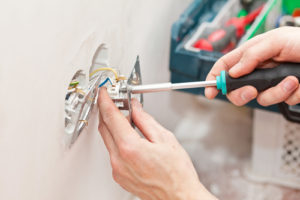Are you building a new home or creating additional space in an existing home? Well if you are then one very important thing that you must consider is getting an electrical system installed. In doing so homeowners must obtain professional help to make sure that installations such as electrical outlet and lighting fixtures are completed properly and in accordance with National Electrical Code.
Electrical Outlet Do’s and Don’ts
 During the course of the installation process electricians will have to place and install electrical switches and outlets in various areas throughout your living space. Outlets are mainly used to connect electrical appliances and devices directly to power sources and not only do they provide convenience to occupants of the home but they also provide safety as well. Nevertheless when the time comes to install these fittings in and around homes there are several factors that need to be considered.
During the course of the installation process electricians will have to place and install electrical switches and outlets in various areas throughout your living space. Outlets are mainly used to connect electrical appliances and devices directly to power sources and not only do they provide convenience to occupants of the home but they also provide safety as well. Nevertheless when the time comes to install these fittings in and around homes there are several factors that need to be considered.
The first thing that homeowners and electricians should decide on are the areas of the home that the outlets will be placed. When installing electrical outlets location, safety and adherence to the National Electrical Code are the most essential factors that determine accurate placement however other factors include the type of room the outlet will be placed and its intended purpose all in effort to plan and conduct a safe and code compliant installation.
There are also several compulsory requirements that are further emphasized by law that must applied when installing outlets in homes. For instance Article 210.52 (A) (1) of the NEC states that:
“A receptacle outlet must be installed in every kitchen, family room, dining room, living room, den, bedroom or recreational room.”
Apart from this The NEC does not specify a minimum or maximum distance that an outlet should occupy away from a door which obviously leaves homeowners and electricians to determine this on their own. The easiest way to retain the uniformity and appropriate placement throughout homes would be to maintain a constant height when measuring, placing and installing outlets.
This is achieved by using two scrap pieces of 2 × 4 to equally measure and secure the areas where outlets are to be placed. This will also ensure that outlets are placed at equal height and that they don’t move up or down during installation.
As it relates to placing outlets by doors this should be done so that outlets are installed behind the door’s swing radius. This is done for a few reasons but mainly to prevent accidents and obstruction of doorways. So before deciding on the location for electrical outlets in close proximity to a door it would be wise to identify all hazards as well as to ensure that their installation complies with the code.
Installing an electrical system is a very serious and complicated project that should not be taken lightly. So if there be any electrical tasks such as installing outlets in your home or new space you should contact us to come in and give you a hand. We can guarantee safety, efficiency and professionalism as well as to make sure that electrical installation is carried out in accordance and compliance with the National Electrical Code.

